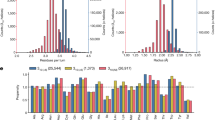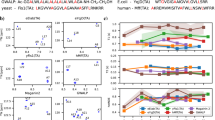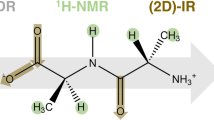Abstract
The conformational properties of a 16 residue peptide, corresponding to the second β-hairpin of the B1 domain of protein G, have been studied by nuclear magnetic resonance spectroscopy (NMR). This fragment is monomeric under our experimental conditions and in pure water adopts a population containing up to 40% native-like β-hairpin structure. The detection by NMR of a native-like β-hairpin in aqueous solution, reported here for the first time, indicates that these structural elements may have an important role in the early steps of protein folding. It also provides a good model to study in detail the sequence determinants of β-hairpin structure stability, as has been done with α-helices.
This is a preview of subscription content, access via your institution
Access options
Subscribe to this journal
Receive 12 print issues and online access
$189.00 per year
only $15.75 per issue
Buy this article
- Purchase on Springer Link
- Instant access to full article PDF
Prices may be subject to local taxes which are calculated during checkout
Similar content being viewed by others
References
Baldwin, R.L. Seeding protein folding. Trends biochem. Sci. 11, 6–9 (1986).
Wright, P.E., Dyson, H.J. & Lerner, R.A. Conformation of peptide fragments of proteins in aqueous solution: implications for initiation of protein folding. Biochemistry 27, 7167–7175 (1988).
Dyson, H.J. & Wright, P.E. Peptide conformation and protein folding. Curr. Opin. struct. Biol. 3, 60–65 (1993).
Brown, J.E. & Klee, W.A. Helix-coil transition of the isolated amino terminus of ribonuclease. Biochemistry 10, 470–476 (1971).
Jiménez, M.A., Herranz, J., Nieto, J.L., Rico, M. & Santoro, J. 1H-NMR and CD evidence of folding of the isolated ribonuclease 50-61 fragment. FEBS Lett. 21 320–324 (1987).
Jiménez, M.A., Rico, M., Herranz, J., Santoro, J. & Nieto, J.L. 1H-NMR assignment and folding of the isolated ribonuclease 21-42 fragment. Eur. J. Biochem. 75 101–109 (1988).
Segawa, S.I., Fukuno, T., Fujiwara, K. & Noda, Y. Local structures in unfolded lysozyme and correlation with secondary structures in the native conformation: helix-forming or breaking propensity of peptide segments. Biopolymers 31, 1497–509 (1991).
Bruch, M.D., Dhingra, M.M. & Gierasch, L.M. Side chain-backbone hydrogen bonding contributes to helix stability in peptides derived from an α-helical region of carboxypeptidase A. Prot. Struct. Funct. Genet. 10, 130–139 (1991).
Dyson, H.J., Merutka, G., Waltho, J.P., Lerner, R.A. & Wright, P.E. Folding of peptide fragments comprising the complete sequence of proteins. Models for initiation of protein folding II. Myohemerytrhin. J. molec. Biol. 226, 795–817 (1992).
Jiménez, M.A. et al. CD and 1H-NMR studies on the conformational properties of peptide fragments from the C-terminal domain of thermolysin. Eur. J. Biochem. 211, 569–581 (1993).
Kemmink, J. & Creighton, T.E. Local conformations of peptides representing the entire sequence of bovine pancreatic trysin inhibitor and their roles in folding. J. molec. Biol. 34 861–878 (1993).
Kuroda, Y. Residual helical structure in the C-terminal fragment of cytochrome c. Biochemistry 32 1219–1224 (1993).
Waltho, J.P., Feher, V.A., Merutka, G., Dyson, H.J. & Wright, P.E. Peptide models of protein folding initiation sites. 1. Secondary structure formation by peptides corresponding to the G- and H-helices of myoglobin. Biochemistry 32, 6337–6347 (1993)
Jiménez, M.A., Muñoz, V., Rico, M. & Serrano, L. NMR analysis of peptides encompassing all the α-helices of three α/β parallel proteins: CheY, Flavodoxin and P21ras. I. Basic principles governing α-helix stability on protein fragments. J. molec. Biol. Submitted, (1994).
Blanco, F.J. et al. Tendamistat (12-26) fragment. NMR Characterization of isolated β-turn folding intermediates. Eur. J. Biochem. 200, 345–351 (1991).
Sönnichsen, F.D., Eyk, J.E.V., Hodges, R.S. & Sykes, B.D. Effect of trifluoroethanol on protein secondary structure: an NMR and CD study using a synthetic actin peptide. Biochemistry 8790–8798 (1992).
Shin, H.C., Merutka, G., Waltho, J.P., Wright, P.E. & Dyson, H.J. Peptide models of protein folding initiation sites. 2. The G-H turn region of myoglobin acts as a helix stop signal. Biochemistry 32, 6348–6355 (1993).
Dyson, H.J. & Wright, P. Defining solution conformations of small linear peptides. A. Rev. Biophys. biophys. Chem. 20, 519–538 (1991).
Cox, J.P.L., Evans, P.A., Packman, L.C., Williams, D.H. & Woolfson, D.N. Dissecting the structure of a partially folded protein. Circular dichroism and nuclear magnetic resonance studies of peptides from ubiquitin. J. molec. Biol. 234, 483–492 (1993).
Blanco, F.J. et al. NMR solution structure of the isolated N-terminal fragment of protein-G B1 domain. Evidence of trifluoroethanol induced native-like β-hairpin formation. Biochemistry 33, 6009–6014 (1994).
Blanco, F.J. et al. NMR evidence of a short linear peptide that folds into a β-hairpin in aqueous solution. J. Am. chem. Soc. 115, 5887–5888 (1993).
Dyson, H.J. et al. Folding of peptide fragments comprising the complete sequence of proteins. Models for initiation of protein folding II. Plastocyanin. J. molec. Biol. 226, 819–835 (1992).
Varley, P. et al. Kinetics of folding of the all-β-sheet protein interleukin-1b. Science 260, 1110–1113 (1993).
Viguera, A.R., Martínez, J.C., Filimonov, V.V., Mateo, P.L. & Serrano, L. Thermodynamic and kinetic analysis of the SH3 domain of spectrin shows a two-state folding transition. Biochemistry 33, 2142–2150 (1994).
Fahnestock, S.R., Alexander, P., Nagle, J. & Filpula, D. Gene for a Immunoglobulin-binding protein from a group G streptococcus. J. Bact. 167, 870–880 (1986).
Gronenborn, A.M. et al. A novel, highly stable fold of the inmunoglobulin binding domain of streptococcal protein G. Science 253, 657–661 (1991).
Alexander, P., Faneshtock, S., Lee, T., Orban, J. & Bryan, P. Thermodynamic analysis of the folding of streptococcal protein G IgG-binding domains B1 and B2: why small proteins tend to have high denaturation temperatures. Biochemistry 31, 3597–3603 (1992).
Woody, R.W. Aromatic side-chain contributions to the far ultraviolet dichroism of peptides and proteins. Biopolymers 17, 1471–1467 (1978).
Wüthrich, K. NMR of Proteins and Nucleic Acids. (John Wiley, New York, 1986).
Jiménez, M.A. et al. A study of the NH NMR signals of Gly-Gly-X-Ala tetrapeptides in H2O at low temperature. J. molec. Struct. 143, 435–438 (1986).
Andersen, N.H. et al. Conformational isomerism of endothelin in acidic aqueous media: a quantitative NOESY analysis. Biochemistry 31, 1280–1295 (1992).
Fehrentz, J.-A. et al. Peptides mimicking the flap of human renin: synthesis, conformation, and antibody recognition. Biochemistry 27, 4071–4078 (1988).
Kemmink, J., van Mierlo, C.P.M., Scheek, R.M. & Creighton, T.E. Local structure due to an aromatic-amide interaction observed by 1H-nuclear magnetic resonance spectroscopy in peptides related to the N-terminus of bovine pancreatic trypsin inhibitor. J. molec. Biol. 230, 312–322 (1993).
Bundi, A. & Wüthrich, K. 1H-NMR parameters of the common amino acid residues measured in aqueous solution of the linear tetrapeptides H-Gly-Gly-X-Ala-OH. Biopolymers. 18, 285–298 (1979).
Wishart, D.S., Sykes, B.D. & Richards, F.M. Relationship between nuclear magnetic resonance chemical shift and protein secondary structure. J. molec. Biol. 222, 1423–1431 (1991).
Peña, M.C. et al. Conformational properties of the isolated 1–23 fragment of human hemoglobin α-chain. Biochim. biophys. Acta 957, 380–389 (1989).
Rizo, J., Blanco, F.J., Kobe, B., Bruch, M.D. & Gierasch, L.M. Conformational behaviour of Escherichia coli OmpA signal peptides in membrane mimetic environments. Biochemistry 32, 4881–4894 (1993).
Alexander, P., Orban, J. & Bryan, P. Kinetic analysis of folding and unfolding the 56 amino acid IgG-binding domain of streptococcal protein G. Biochemistry 31, 7243–7248 (1992).
Jackson, S.E. & Fersht, A.R. Folding of chymotrypsin inhibitor 2.1. Evidence for a two state transition. Biochemistry 30, 10428–10435 (1991).
Gronenborn, A.M. & Clore, G.M. Experimental support for the “hydrophobic zipper” hypothesis. Science 263, 536 (1994).
Burley, S.K. & Petsko, G.A. Electrostatic interactions in aromatic oligopeptides contribute to protein stability. Trends Biotechnol. 7, 354–359 (1989).
Serrano, L., Bycroft, M. & Fersht, A.R. Aromatic-aromatic interactions and protein stability: investigation by double mutant cycle. J. molec. Biol. 218, 465–475 (1991).
Minor, D.L.J. & Kim, P.S. Measurement of the β-sheet-forming propensities of amino acids. Nature 367, 660–663 (1994).
Scholtz, J.M. & Baldwin, R.L. The mechanism of α-helix formation by peptides. A. Rev. Biophys. biomolec. Struct. 21, 95–118 (1992).
Gill, S.C. & von Hippel, P.H. Calculation of protein extintion coefficients from amino acid sequence data. Anal. Biochem. 182, 319–326 (1989).
Laue, T.M., Shah, B.D., Ridgeway, T.M. & Pelletier, S.L. Computer-aided interpretation of analytical sedimentation data for proteins in Analytical Ultracentrifugation in Biochemistry and Polymer Science (Eds Harding, S. E., Rowe, A.J. & Horton, J.C.) 90–125 (Royal Society of Chemistry, Cambridge, 1992).
Ralston, G. Introduction to analytical ultracentrifugation. Beckman Instruments Inc., CA (1993).
McRorie, D.K. & Voelker, P.J. Self-associating systems in the analytical centrifuge. Beckman Instruments Inc., CA (1993).
Kim, H., Deonier, R.C. & Williams, J.W. The investigation of self-association reactions. Chem. Rev. 77, 659–690 (1977).
Hsu, C.S. & Minton, A.P. A strategy for efficient characterization of macromolecular heteroassociations via measurements of sedimentation equilibrium. J. molec. Recog. 4, 93–104 (1991).
INSIGHTII (version 2.2.0). Biosym technologies, 9685 Scranton Road, San Diego, CA 92121–92777 (1993).
Author information
Authors and Affiliations
Rights and permissions
About this article
Cite this article
Blanco, F., Rivas, G. & Serrano, L. A short linear peptide that folds into a native stable β-hairpin in aqueous solution. Nat Struct Mol Biol 1, 584–590 (1994). https://doi.org/10.1038/nsb0994-584
Received:
Accepted:
Issue Date:
DOI: https://doi.org/10.1038/nsb0994-584
This article is cited by
-
Synthesis of a glycan hairpin
Nature Chemistry (2023)
-
Atomistic Peptide Folding Simulations Reveal Interplay of Entropy and Long-Range Interactions in Folding Cooperativity
Scientific Reports (2018)
-
Probing the Gaseous Structure of a β-Hairpin Peptide with H/D Exchange and Electron Capture Dissociation
Journal of the American Society for Mass Spectrometry (2017)
-
Conformation-dependent affinity of Cu(II) ions peptide complexes derived from the human Pin1 protein
Journal of Thermal Analysis and Calorimetry (2017)
-
The effects of organic solvents on the folding pathway and associated thermodynamics of proteins: a microscopic view
Scientific Reports (2016)



